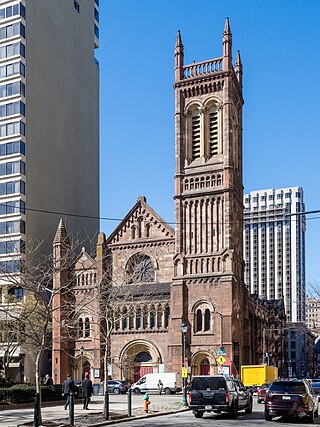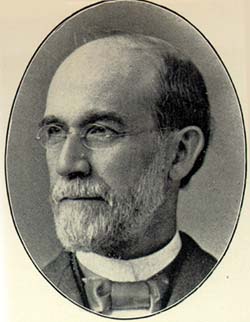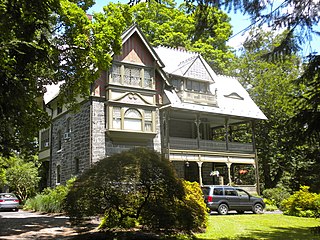
Germantown is an area in Northwest Philadelphia, Pennsylvania. Founded by Palatine, Quaker, and Mennonite families in 1683 as an independent borough, it was absorbed into Philadelphia in 1854. The area, which is about six miles northwest from the city center, now consists of two neighborhoods: 'Germantown' and 'East Germantown'.

Chestnut Hill is a neighborhood in the Northwest Philadelphia section of Philadelphia, Pennsylvania, United States. It is known for the high incomes of its residents and high real estate values, as well as its private schools.

Frank Heyling Furness was an American architect of the Victorian era. He designed more than 600 buildings, most in the Philadelphia area, and is remembered for his diverse, muscular, often inordinately scaled buildings, and for his influence on the Chicago-based architect Louis Sullivan. Furness also received a Medal of Honor for bravery during the Civil War.

St. Stephen's Episcopal Church is a historic parish of the Episcopal Diocese of Pennsylvania, founded in 1823 in Philadelphia, Pennsylvania and located at 19 South Tenth Street, on the corner of Tenth Street and Ludlow Street. St. Stephen's was designed by William Strickland in the Gothic revival style. It is the oldest extant building in Philadelphia in this style and was designed by an architect-engineer best known for Greek Revival buildings, though, like his mentor Benjamin Latrobe, he produced buildings in other "picturesque" styles as well. St. Stephen's first service was held on February 27, 1823. On June 4, 1979, it was added to the National Register of Historic Places. On May 28, 1957, it was designated a historic landmark by the Philadelphia Historical Commission.

Ogontz/Belfield is a neighborhood in Upper Northern Philadelphia that is located adjacent to West Oak Lane, East Germantown, Logan, and Fern Rock, Philadelphia, Pennsylvania, United States.

The Germantown White House is a historic mansion in the Germantown section of Philadelphia, Pennsylvania. It is the oldest surviving presidential residence, having twice housed Founding Father George Washington during his presidency.

Saint Mark's Episcopal Church is an Episcopal church located at 1625 Locust Street in Rittenhouse Square in Center City Philadelphia. It is part of the Diocese of Pennsylvania.

Samuel Sloan was a Philadelphia-based architect and best-selling author of architecture books in the mid-19th century. He specialized in Italianate villas and country houses, churches, and institutional buildings. His most famous building—the octagonal mansion "Longwood" in Natchez, Mississippi—is unfinished; construction was abandoned during the American Civil War.

G. W. & W. D. Hewitt was a prominent architectural firm in the eastern United States at the turn of the twentieth century. It was founded in Philadelphia in 1878, by brothers George Wattson Hewitt (1841–1916) and William Dempster Hewitt (1847–1924), both members of the American Institute of Architects. The firm specialized in churches, hotels and palatial residences, especially crenelated mansions, such as Maybrook (1881), Druim Moir (1885–86) and Boldt Castle (1900–04).

Church of the Holy Trinity is an Episcopal church on Rittenhouse Square in Philadelphia. The first service in the church building, designed by Scottish architect John Notman, was held on March 27, 1859. The corner tower was added in 1867 and was designed by George W. Hewitt of the firm of Fraser, Furness & Hewitt. It is designed in the simpler "low church" style, rather than the fancier "high church" or Anglo-Catholic style of Notman's nearby St. Marks Episcopal Church.

Addison Hutton (1834–1916) was a Philadelphia architect who designed prominent residences in Philadelphia and its suburbs, plus courthouses, hospitals, and libraries, including the Ridgway Library, now Philadelphia High School for the Creative and Performing Arts, and the Historical Society of Pennsylvania. He made major additions to the campuses of Westtown School, George School, Swarthmore College, Bryn Mawr College, Haverford College, and Lehigh University.

The Pennsylvania School for the Deaf is the third-oldest school of its kind in the United States. Its founder, David G. Seixas (1788–1864), was a Philadelphia crockery maker-dealer who became concerned with the plight of impoverished deaf children who he observed on the city's streets. The current school building is listed by the National Register of Historic Places, and two former campuses are similarly recognized.

The Chestnut Hill Historic District is a historic area covering all the Chestnut Hill section of Philadelphia, Pennsylvania.

St. Michael's Episcopal Church, Parish House and Rectory is a group of architecturally-significant religious buildings located at 200-216 North Mill Street in Birdsboro, Berks County, Pennsylvania. It was added to the U.S. National Register of Historic Places in 1982.

St. Paul's Episcopal Church is a historic Episcopal church at Old York and Ashbourne Roads in Elkins Park, Cheltenham Township, Montgomery County, Pennsylvania. It was originally built in 1861, and is a gray stone church in the Gothic style. The church was conceived by noted financier Jay Cooke (1821–1905), along with John W. Thomas, J.F. Peniston and William C. Houston. Its size was doubled with an expansion in 1870, and a 60-foot-tall tower added. A transept was added in 1883, and the two-story parish hall wing in 1891. Architect Horace Trumbauer (1868–1938) made some refinements to the church during the 1897 to 1924 period. The main sanctuary of the church features 13 stained glass windows from Tiffany studios.

The Tulpehocken Station Historic District is a historic area in the Germantown neighborhood of Philadelphia, Pennsylvania. Large suburban houses were built in the area from about 1850 to 1900 in a variety of styles including Carpenter Gothic, Italianate, and Bracketed as part of the Picturesque Movement of architecture. In the 1870s styles moved toward High Victorian and Second Empire. The district was added to the National Register of Historic Places in 1985, and it covers about six square blocks, bounded by McCallum Street on the north, the Pennsylvania Railroad tracks on the south, Tulpehocken Street on the west, and Walnut Lane on the east. Thirty-seven buildings in the district are considered to be significant and 118 are considered to be contributing, with only 13 considered to be intrusions.
Isaac Pursell was a Philadelphia, Pennsylvania-based architect.

Furness & Evans was a Philadelphia-based architectural partnership, established in 1881, between architect Frank Furness and his former chief draftsman, Allen Evans. In 1886, other employees were made partners, and the firm became Furness, Evans & Company. George Howe worked in the firm and later became a partner at Mellor & Meigs, another Philadelphia firm.

Edmund Beaman Gilchrist was an American architect, best remembered for his English-Cotswold and French-Norman suburban houses.
St. David's Episcopal Church is a parish of the Episcopal Diocese of Pennsylvania in the Manayunk neighborhood of Philadelphia, Pennsylvania. It is part of the Wissahickon Deanery of the Diocese of Pennsylvania. In 1960, the parish reported 621 members; it reported 23 members in 2022. English-born mill-workers were heavily represented in its early population, while mill owners were successive wardens, vestrymen, and treasurers.























